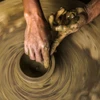Coffee shops here are imbued with Nha Trang’s typical characteristics:serene, relaxing and instilled with a sense of freedom.
Most of the most beautiful cafes are located near the seashore, withstunning views out to sea. Sitting here, drinkers can enjoy the sunnybeaches, rows of coconut trees and many others of the city’s beauties.
Sitting on a special location, Me Trang cafe isincluded in an educational project linking the company and Nha TrangUniversity .
It aims to provide a practicecentre for students to test their theoretical knowledge in reality,giving them a clearer idea of the career demands needed after theirgraduation.
Pham Minh Son, a Nha Trang cityresident, said: “Drinking coffee here is my way of enjoying some leisuretime. Sometimes I drink four cups of coffee a day.”
“This is myvery favourite cafe. Sitting here, I can taste the delicious flavor ofcoffee while enjoying the stunning beauty of Nha Trang’s landscape,” headded.
People here do not drink coffee on the run.They brew their coffee at a leisurely pace and in single servings usingno paper filters or other devices aside from a simple metal filtercalled Phin.
It’s true in Nha Trang people consumehot and ice-cold coffee throughout the day at their homes, inrestaurants, in cafes and on the streets. The popularity of coffee herehas something to do with the city’s proximity to the highlands incentral Vietnam , where the coffee is cultivated and brought to NhaTrang for consumption.
While other coffee-producingregions in the world focus more on single origin blends based mostly onthe Arabica variety, Vietnam has opted for a multi-origin blendwhich most consumers here prefer. It has become, after Brazil , theworld’s second largest coffee producer.
The qualityand the taste of coffee, like wine, depend on a variety of factors,including the native soil, the climate, the elevation and the methods ofharvesting and the means of roasting and processing. These are each asimportant as the species of the coffee bush.
Sincethe French introduced coffee in the Central Highlands province ofDak Lak in the 18 th century, Vietnamese coffee producers have builtup an enormous wealth of know-how and experience which has been turnedinto remarkable commercial success.
Visitors to Nha Trang will miss out on a part of its culture if they do not try Vietnamese-style brewed coffee there.-VNA
























